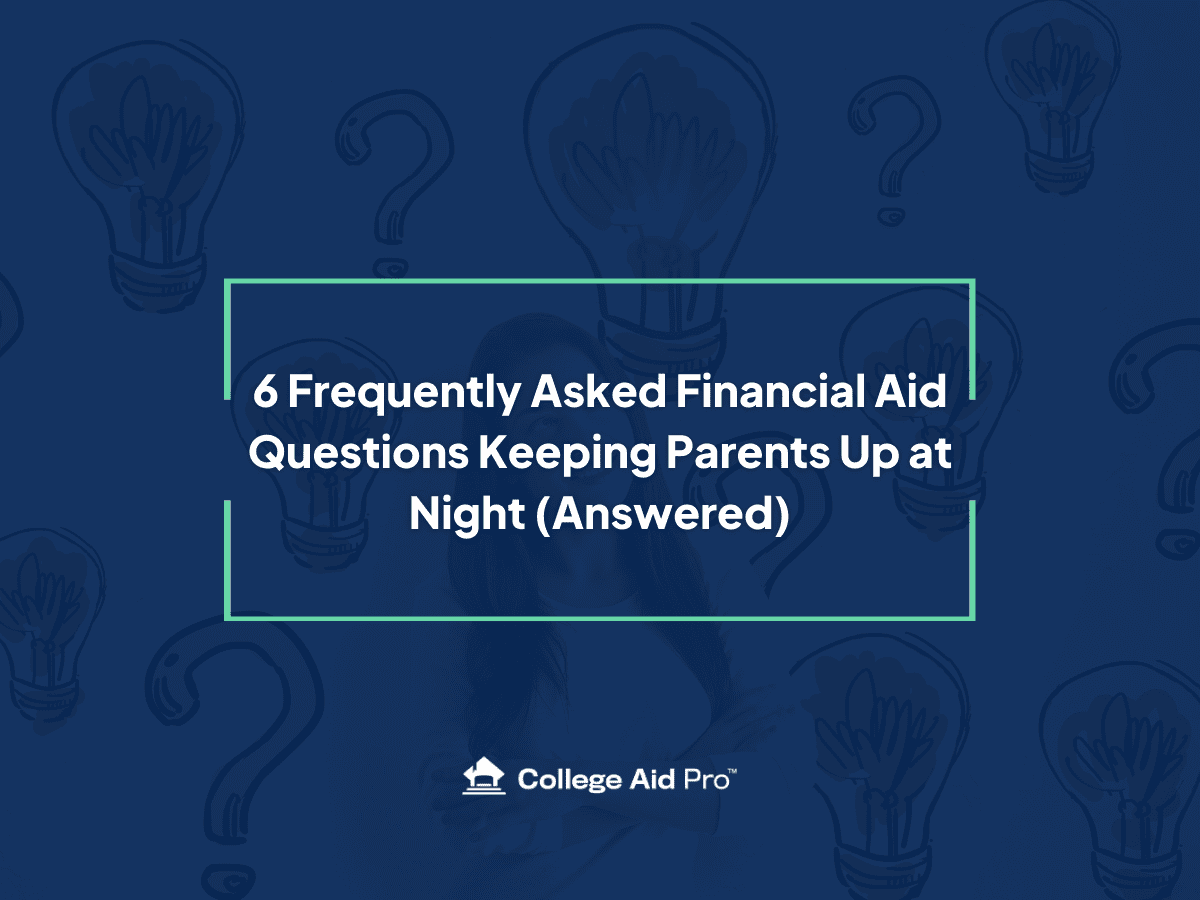FAFSA Week Of Action – April 15 – 19 2024
At College Aid Pro, we are fully committed to being an advocate for families. We cherish all of our stakeholders and partners, including school counselors, IECs, and financial advisors, but above all else we are here to support students and their families in their pursuit of higher education.
This is why when we hear about things like the White House’s call for a FAFSA Week of Action, we do what we can to jump to attention. The underlying need for this Week of Action is ultimately why CAP exists, after all (more on this below).
For upcoming high school graduates and their families (as well as students already in college), filling out the FAFSA is a critical piece to minimizing the cost of college and reducing or even eliminating the debt you may need to take on. It may seem like yet another piece of red tape in the lengthy and cumbersome college application process, but this particular piece of paperwork has meaningful dollars directly associated with it.
Below I explain why submitting the FAFSA is so important and why paying attention to the details is absolutely mandatory this year in particular.
But first, if you haven’t completed your 2024-2025 FAFSA yet, I encourage you to register for our FAFSA Power Hour webinar. We will work with you to finish and submit your FAFSA during the webinar. This is one of the main events we are putting on for all of our students and families to answer the Week of Action call. So join us and let’s get YOUR FAFSA knocked out.
Why is the FAFSA so important and why have a Week of Action?
The Free Application for Federal Student Aid (FAFSA) is a form completed by college-bound students who are seeking financial assistance for college or graduate school. It’s used by federal, state, and institutional financial aid programs to determine eligibility for grants, scholarships, work-study, and loans.
The FAFSA collects information about the student’s family’s income, assets, and household size to calculate the Student Aid Index (SAI), which is used to assess the student’s financial need. Students must complete the FAFSA each year they wish to receive financial aid, and deadlines vary depending on the school and state. Most colleges in the US only require this financial aid form and they use it to award their institutional aid (a.k.a. endowment money). Not submitting this form could literally mean a family is leaving tens of thousands of dollars in aid on the table.

In the landscape of higher education, financial aid is a crucial bridge between aspiration and accessibility. Recent trends, however, suggest a concerning decline in FAFSA submissions, particularly among lower-income families. The decline in submissions among lower-income families has far-reaching implications for educational equity and social mobility. Without adequate financial support, many deserving students are unable to pursue their academic aspirations, perpetuating intergenerational cycles of poverty and limiting economic opportunity.
FAFSA participation trends since 2010:
- Post-Recession Surge (2010 to 2013):
-
- In the aftermath of the Great Recession, FAFSA submissions surged as families sought financial assistance to cope with economic hardships and secure opportunities for higher education
- The Obama administration pushed for the expansion of Pell Grants and increased federal funding for student aid contributed to heightened awareness and participation in the FAFSA process
- Peak and Plateau (2014 to 2016):
-
- FAFSA submission rates reached a peak and plateaued during this period, reflecting a degree of stability in the availability and utilization of financial aid resources
- The Obama administration introduced policy reforms aimed at simplifying the FAFSA application process, including the use of prior-prior year (PPY) income data and the implementation of the “Early FAFSA” timeline, which allowed students to submit their applications earlier
- Fluctuations and Challenges (2017 to 2020):
-
- The transition to the Trump administration brought about changes in federal education policies, including proposals to cut funding for student aid programs and revisions to loan forgiveness programs
- These policy shifts may have influenced FAFSA submission rates, contributing to fluctuations in participation levels
- Technological barriers and access challenges, exacerbated by the digital divide and disparities in internet connectivity, posed obstacles to FAFSA completion, particularly for students from underserved communities
- The onset of the COVID-19 pandemic in early 2020 disrupted educational systems and exacerbated economic hardships, potentially impacting FAFSA submission rates as families grappled with uncertainty and financial instability and the benefit of a virtual college experience
- Recovery and Improvement Efforts (2021 to 2023):
-
- Recognizing the importance of financial aid in facilitating access to higher education, concerted efforts have been made to encourage FAFSA completion
- These efforts include targeted outreach campaigns, virtual assistance resources, and policy initiatives aimed at simplifying the application process
- Specifically, The FAFSA Simplification Act was intended to do just this, and it was signed into law by President Donald Trump in December 2020
- This act aimed to streamline the FAFSA application process by reducing the number of questions and simplifying eligibility criteria
- New FAFSA Rollout (2023 to present):
-
- Which brings us to today…
So, the FAFSA Simplification Act and related process improvements were supposed to help solve the FAFSA participation problem, but for this first year at least it has made the problem exponentially worse.
What has gone wrong?
In a word: everything.
For starters, the FAFSA was opened for applicants over three months later than the typical October 1st launch date. This delay, while in and of itself not the end of the world, did put meaningful pressure on the efficacy of the new form when it was opened. Said another way, losing three months off the bat removed any wiggle room for glitches if colleges and students were expected to remain on any resemblance of a normal timeline. Regretfully, the delayed start was just the beginning.
After an awkwardly coordinated “soft launch” of the new form in late December, the form immediately had widespread bugs and dismal user experience. Common issues included major difficulties logging in, an inability to progress past certain screens, unclear messaging at the point of submission, among many other similar issues. For those that did get through without any major hiccups, the feedback was positive: the form is shorter and simpler, as intended. For the majority of users, however, the feelings were more of extreme frustration and understandable confusion. What’s worse, many applicants found the process so infuriating that they abandoned it entirely and never submitted the FAFSA at all. Not exactly what the FAFSA Simplification Act was supposed to accomplish.
The final straw for even the most patient government supporter came over the past week when it was announced that the tax data provided for as many as 1 out of 5 submitted FAFSAs might be incorrect. Delays, bug-ridden rollout, and now faulty information leading to incorrect results.
So now what?
As of March 29, FAFSA submission numbers are a whopping 40% lower than last year through the same date. If the season was over today, this would be a catastrophic failure of epic proportions. It may still end up being close to that, but there is still time on the clock to try like hell to turn this thing around. For myself and everyone at College Aid Pro (and many other great organizations around the country), we are doing everything we can to help families make up this lost ground.

How are we helping?
College Aid Pro will be running a series of special events, such as the FAFSA Power Hour event mentioned above, to support Class of 2024 students and families. Please register here for the Power Hour event or sign up with us here to get on our distribution list so you can hear about other upcoming webinars.
Additionally, we highly recommend you create a free MyCAP account (here) if you have not already done so. At a minimum, you can get a sanity check on what your SAI should be to make sure you are not one of the 20% of people with incorrect calculations being provided to colleges.
After doing this, please also take advantage of our financial aid Award Translator and Appeal Evaluator functions that will let you know if the award you received is what it should be. Even if the data was passed over correctly from the Department of Education, colleges may still try to under-award you. Our software will tell you if that’s the case.
In Conclusion:
Significant actions need to be taken by the Department of Education to right the ship and restore trust and confidence, but these will take time. To help the students and families going through this right now, all members of the college admissions and financial aid support system need to do their part. Increased awareness and expanded outbound initiatives are a big part of how we’re going to get there. Thank you to everyone else who is trying to step up and if you know someone who is in need of some support, please send them our way. This is what we’re here for.




